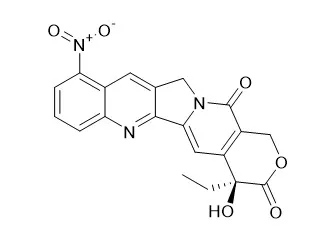| In vivo: |
| Journal of Clinical Oncology, 2005, 23(16):349S. | | Patients rescued by crossover to rubitecan in phase III study of rubitecan capsules versus 5-FU in pancreatic cancer.[Reference: WebLink] | Rubitecan (Orathecin) is a novel oral inhibitor of topoisomerase I in the camptothecin class.
METHODS AND RESULTS:
A Phase III randomized multinational open-label study of Rubitecan versus 5-FU in pancreatic cancer patients who had progressive disease following gemcitabine treatment was undertaken. The primary endpoint was overall survival. Key patient eligibility criteria included pathologic diagnosis of pancreatic cancer, progressive disease on gemcitabine, Karnofsky Performance Status of 50 and life expectancy of 2 months. Rubitecan was administered at 1.5 mg/morally 5 days/week. 5-FU was administered at 600 mg/mintravenously once weekly. Patients who progressed or experienced intolerable toxicity could crossover to the alternate treatment arm. 93 of 224 (41%) 5-FU patients crossed over to Rubitecan rescue. Only 1 of 224 Rubitecan patients crossed over to 5-FU. Main reasons for rescue with Rubitecan were radiologic (75%) and symptomatic (12%) progression on 5-FU. Median survival from randomized baseline was longer for patients who crossed over from 5-FU to Rubitecan rescue compared to patients who did not crossover from 5-FU (184 versus 66 days). 35 of 93 (38%) patients had follow-up scans after the initiation of Rubitecan rescue and were evaluable for tumor response assessment. 14 of 35 (40%) patients achieved tumor growth control (4 had objective tumor responses and 10 had disease stabilization). The most common Grade 3/4 adverse events with Rubitecan were myelotoxicity (34%) and gastrointestinal (14%). All deaths on study were primarily related to disease progression.
CONCLUSIONS:
These results support that patients with refractory/resistant pancreatic cancer, who have progressed on gemcitabine and 5-FU, can derive benefit from Rubitecan, an oral medication that can be taken at home with manageable toxicity. | | Clin Colorectal Cancer. 2004 Sep;4(3):163-80. | | Topoisomerase I inhibitors in the treatment of gastrointestinal cancer: from intravenous to oral administration.[Pubmed: 15377400] | This article reviews the current status of the topoisomerase I (top I) inhibitors in the treatment of gastrointestinal (GI) malignancies.
METHODS AND RESULTS:
We focus on oral drug administration, the mode of administration that is generally preferred by patients with cancer. However, the great majority of the studies have been performed with intravenous (I.V.) administration. The most extensively investigated GI malignancy in phase I/II studies is colorectal cancer (CRC), for which I.V. irinotecan is currently approved in the United States and Europe. We discuss the activity and efficacy of irinotecan as a single agent in CRC and in combination regimens. Also, results obtained with monotherapy and in combination treatment in other GI malignancies such as esophageal, gastric, and pancreatic cancer are discussed. Few phase I studies have been performed with oral irinotecan and its clinical activity has not yet been fully determined. Several top I inhibitors are discussed, including topotecan, 9-aminocamptothecin, Rubitecan, exatecan, and lurtotecan. None of these agents, given orally or intravenously, have shown activity in CRC similar to that of I.V. irinotecan. However, several agents show promising results in other GI malignancies, eg, Rubitecan and exatecan in pancreatic cancer. A complicating factor in the oral administration of the top I inhibitors is the often encountered low and variable oral bioavailability. This can partly be explained by the high affinity for the drug efflux pumps BCRP (ABCG2) and P-glycoprotein, which are highly expressed in the epithelial apical membrane of the GI tract.
CONCLUSIONS:
A novel approach to improve the oral bioavailability of the top I inhibitors by temporary blockade of the drug transporter BCRP is described. |
|






 Cell. 2018 Jan 11;172(1-2):249-261.e12. doi: 10.1016/j.cell.2017.12.019.IF=36.216(2019)
Cell. 2018 Jan 11;172(1-2):249-261.e12. doi: 10.1016/j.cell.2017.12.019.IF=36.216(2019) Cell Metab. 2020 Mar 3;31(3):534-548.e5. doi: 10.1016/j.cmet.2020.01.002.IF=22.415(2019)
Cell Metab. 2020 Mar 3;31(3):534-548.e5. doi: 10.1016/j.cmet.2020.01.002.IF=22.415(2019) Mol Cell. 2017 Nov 16;68(4):673-685.e6. doi: 10.1016/j.molcel.2017.10.022.IF=14.548(2019)
Mol Cell. 2017 Nov 16;68(4):673-685.e6. doi: 10.1016/j.molcel.2017.10.022.IF=14.548(2019)